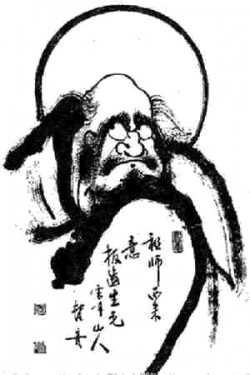Bodhidharma said there are two ways to enter the path.
Entry through conduct and entry through principle.
He outlined this in a teaching called the Two Entries and the Four Practices. In this teaching he outlines in a clear way what we must do to attain enlightenment.
Entry through conduct is associated with practices that need to be done. This applies to those aspects of our training that require effort, our spiritual cultivation.
Entry through principle is considered the essence of the Ch’an path. It applies to directly seeing our true nature, which is beyond words, descriptions and forms.
In the practice of the Dharma, both of these things need to be used. Entry through principle represents the cultivation of insight through meditation. Entry through conduct represents the cultivation of discipline.
Entry through conduct is the path of the Dharma as it’s explained in the sutras and commentaries. It is an approach that involves modifying behavior and spiritual cultivation, in which concentration is expanded through meditative practices. It also involves efforts at countering the three poisons: hatred, greed, and delusion.
Entry through conduct is practiced through four methods:
1) The practice of repaying wrongs.
2) The practice of adjusting to circumstance.
3) The practice of non-seeking or asking for anything.
4) The practice of upholding the Dharma.
Repaying wrongs represents understanding that our actions have consequences and trying to mitigate negative consequences that we have caused. This has been described as karma. Our karma has to be understood and improved.
Adjusting to circumstance means doing our best within our environment. Accepting our conditions instead of becoming attached to them is important. Attachment to our circumstances can be either positive or negative. We can enjoy our circumstances too much and be too excited by them. We can also hate our circumstances too much and view life in a very negative way. These are two sides of attachment.
Non-seeking means acting without attachment to personal gain either now or in the future. The self is a delusion, a label we put on our interaction with our environment. If we act in a way that is attached to receiving praise or blame, this is not helpful. In a way, this could be said to be an advanced practice.
Many people come to Buddhism with hope for a gain, for some kind of benefit from practice. But, eventually when one practices, self-centeredness does start to fall way. When we are concerned about our Enlightenment, it can be a barrier to our Enlightenment. Wanting to achieve some attainment can stop us from perceiving the Empty Mind Ground.
The Practice of Upholding the Dharma represents our attempt to perceive the emptiness and impermanence. Our practice allows us to reach the point of Entry through principle. Different branches of Buddhism have different methods of engaging this practice. In Ch’an the method involves meditation but also interaction with a Ch’an teacher.
Altering our behavior in this way is supposed to calm our minds and bring us to a point at which we can perceive the Empty Mind Ground.
Entry through principle is a different method that Bodhidharma taught. It represents an insight into our true nature. It is a method for touching the Empty Mind Ground right now and it is difficult for us to understand on an intellectual level.
Bodhidharma said:
When conveying the tradition of enlightenment, it is understood that all beings—whether enlightened or unenlightened—share exactly the same true nature. However, the Buddha-nature is obscured by a layer of dust which prevents the ‘real’ from manifesting. Give-up delusion and return to the real by concentrating (and stilling) the mind so that it is broad, and all inclusive. Then there is no self or other, and there is no difference between a sage and an ordinary person. Firm and unmoving, there is no falling into the written teachings. This deep realisation is in accord with the principle. There is no discrimination, and all is silent and non-active (无为 – Wu Wei).
This is the most important principle of Ch’an, as it was taught by Bodhidharma. The enlightened state is our true nature. We have delusions that are preventing us from realizing that, but if we can get past those, then we can enter the Empty Mind Ground. This means leaving behind our delusions and our discrimination between self and other.
Bodhidharma’s message is the message of many of the Mahayana sutras, that nirvana and samsara, enlightenment and worldliness, are really one and the same. This is, in a way, a rebellion against the Theravada ideal that preceded it.
Theravada Buddhism promoted the notion that nirvana is something we are trying to attain, some special dimension of reality that we are trying to reach.
Bodhidharma’s teaching challenges Theravada Buddhism, because it takes away the idea that Enlightenment is only available to an elite few accomplished monks, and declares that it’s available to everyone, in this very moment.
As samsara and nirvana share the same essence, there is no difference. As the entry through insight and the entry through conduct share the same essence, there is no difference between them either.
Enlightenment is available to all of us, right this moment.
These two entries are the foundation of the Ch’an School in China.
Love elephant and want to go steady?
Sign up for our (curated) daily and weekly newsletters!
Editor: Rachel Nussbaum
Photo: elephant archives







Read 2 comments and reply